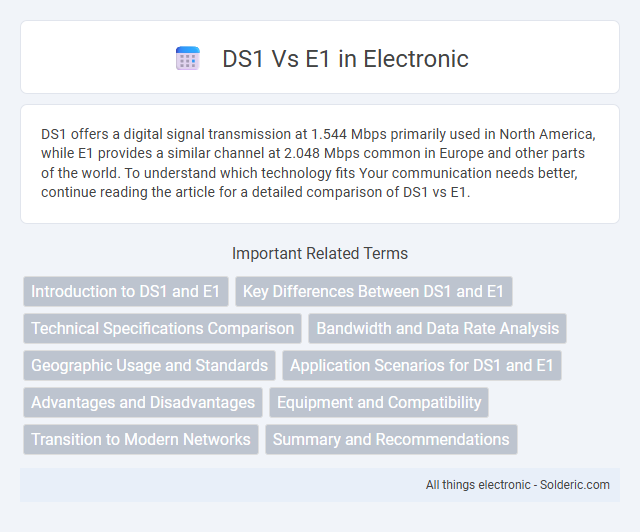DS1 offers a digital signal transmission at 1.544 Mbps primarily used in North America, while E1 provides a similar channel at 2.048 Mbps common in Europe and other parts of the world. To understand which technology fits Your communication needs better, continue reading the article for a detailed comparison of DS1 vs E1.
Comparison Table
| Feature | DS1 | E1 |
|---|---|---|
| Region | Primarily North America | Primarily Europe and Asia |
| Data Rate | 1.544 Mbps | 2.048 Mbps |
| Channels | 24 DS0 channels (64 Kbps each) | 32 DS0 channels (64 Kbps each) |
| Framing | Superframe (SF) or Extended Superframe (ESF) | Basic Frame (PCM30) |
| Line Coding | Bipolar with 8-zero substitution (B8ZS) | HDB3 (High-Density Bipolar 3 zeros) |
| Application | Telephony, Digital Signal Transmission | Telephony, Digital Signal Transmission |
| Standard | T1 (ANSI T1.403) | E1 (ITU-T G.703) |
Introduction to DS1 and E1
DS1 and E1 are digital transmission formats used in telecommunications to transport multiple voice and data channels simultaneously; DS1, primarily used in North America, operates at a rate of 1.544 Mbps carrying 24 channels, while E1, common in Europe, runs at 2.048 Mbps with 32 channels. Your choice between DS1 and E1 depends on regional standards and network requirements, with DS1 fitting T-carrier systems and E1 aligning with E-carrier infrastructure. Both serve as foundational building blocks for higher-capacity digital networks and voice communications worldwide.
Key Differences Between DS1 and E1
DS1 and E1 are digital transmission formats primarily used in telecommunications, with DS1 operating at 1.544 Mbps carrying 24 channels and E1 operating at 2.048 Mbps supporting 32 channels. DS1 is predominantly used in North America and Japan, while E1 is the standard in Europe and most other parts of the world. The channel structure and framing methods differ significantly, as DS1 uses the T1 framing format and E1 employs the G.704 framing standard.
Technical Specifications Comparison
DS1 provides a digital signal level 1 service with a data rate of 1.544 Mbps, using 24 channels each carrying 64 Kbps voice or data. E1 offers a transmission rate of 2.048 Mbps, consisting of 32 channels at 64 Kbps each, commonly used in Europe and other regions outside North America. Both utilize time-division multiplexing (TDM), but DS1 features a framing structure with 193 bits per frame while E1 frames contain 256 bits, affecting synchronization and signaling methods.
Bandwidth and Data Rate Analysis
DS1 offers a data rate of 1.544 Mbps over 24 channels, primarily used in North America for T1 lines, while E1 delivers 2.048 Mbps across 32 channels, predominantly used in Europe. The higher bandwidth of E1 allows for greater data throughput and more simultaneous voice or data transmissions. Both standards utilize Time Division Multiplexing (TDM), but E1's increased capacity supports enhanced telecommunication needs and network scalability.
Geographic Usage and Standards
DS1 is primarily used in North America following the T-carrier standard, whereas E1 is the standard in Europe and most other regions under the E-carrier system. DS1 supports 24 channels at 1.544 Mbps, conforming to ANSI T1.403 standards, while E1 offers 32 channels at 2.048 Mbps as defined by ITU-T G.703. Your choice between DS1 and E1 depends largely on the geographic location and compatibility with regional telecommunications infrastructure.
Application Scenarios for DS1 and E1
DS1 is predominantly used in North American telecommunication networks for digital voice and data transmission, supporting applications such as T1 lines in business internet connectivity and private branch exchange (PBX) systems. E1, widely deployed across Europe and other international regions, serves similar purposes in digital carrier systems, including ISDN PRI lines and large-scale corporate voice services. Both DS1 and E1 facilitate efficient multiplexing of multiple voice and data channels, with DS1 channels at 1.544 Mbps and E1 channels at 2.048 Mbps tailored to regional infrastructure standards.
Advantages and Disadvantages
DS1 offers higher data transmission rates up to 1.544 Mbps, making it ideal for T1 lines in North America and Japan, whereas E1 supports 2.048 Mbps, commonly used in Europe and other regions. DS1's main advantage is widespread compatibility with legacy systems, while E1 provides greater bandwidth but may require specialized equipment. Your choice depends on the regional infrastructure and bandwidth needs, balancing DS1's compatibility against E1's higher data capacity.
Equipment and Compatibility
DS1 and E1 use different equipment standards; DS1 typically operates over T-carrier systems in North America, whereas E1 is standardized for European telecommunications and employs CEPT specifications. DS1 equipment supports 24 channels at 1.544 Mbps, using AMI or B8ZS line coding, while E1 provides 32 channels at 2.048 Mbps with HDB3 coding. Compatibility between DS1 and E1 requires protocol converters or gateways due to differing framing, line coding, and channel structures, ensuring seamless integration in mixed network environments.
Transition to Modern Networks
DS1 and E1 serve as foundational digital transmission standards in telecommunications, with DS1 offering 1.544 Mbps primarily in North America and E1 providing 2.048 Mbps in Europe and other regions. The transition to modern networks leverages these protocols as legacy backbones, facilitating integration with IP-based systems and enhancing bandwidth capacity through technologies like T1/E1 over IP. Network operators often deploy hybrid architectures combining DS1/E1 circuits with Ethernet and MPLS to ensure seamless migration toward all-IP environments and support advanced services.
Summary and Recommendations
DS1 and E1 are digital transmission formats used in telecommunications, with DS1 primarily deployed in North America and E1 in Europe and other regions. DS1 operates at 1.544 Mbps and supports 24 channels, while E1 runs at 2.048 Mbps with 32 channels, offering higher capacity for voice and data transmission. Choose DS1 for compatibility with North American infrastructure and E1 for European systems or when requiring greater channel density and bandwidth efficiency.
DS1 vs E1 Infographic

 solderic.com
solderic.com